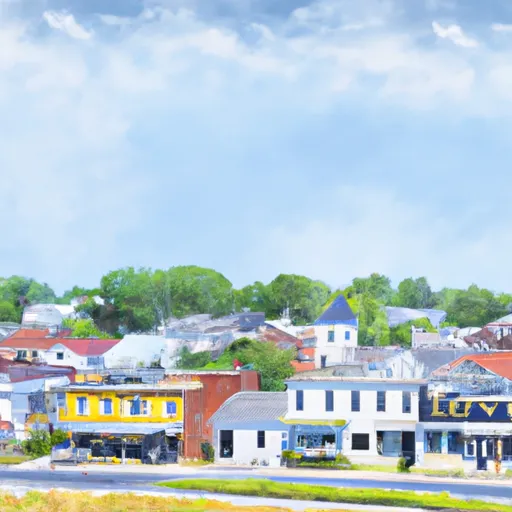-
 Snoflo Premium
Snoflo Premium
Get unlimited access to all our content
With no Ad interruptions! - Start Your Free Trial Login with existing account
Little-Orleans
Eden Index
Climate
9.8
•
Recreation
5.5
•
Community
•
Safeguard
5.8/10

Little Orleans is a small unincorporated community located in Allegany County, Maryland. Situated in the western part of the state, it offers a scenic and tranquil environment for outdoor enthusiasts. The climate in Little Orleans is classified as humid continental, characterized by warm summers and cold winters. Summers are generally mild with temperatures ranging from 70°F to 85°F, while winters can be chilly with temperatures dropping to around 30°F.
The area is rich in hydrology constituents, with the Potomac River flowing nearby. This provides opportunities for water-based activities such as fishing, boating, and kayaking. The river is known for its diverse fish population, including bass, catfish, and trout, attracting anglers of all levels.
Little Orleans is surrounded by picturesque mountains and dense forests, making it an excellent destination for hiking, camping, and wildlife observation. The nearby Green Ridge State Forest offers over 50 miles of trails, allowing visitors to explore the area's natural beauty.
For those seeking a more adventurous experience, the C&O Canal Towpath passes through Little Orleans, providing opportunities for biking, jogging, and horseback riding. This historic trail stretches 184.5 miles and is perfect for outdoor enthusiasts looking to immerse themselves in the region's history and natural wonders.
In conclusion, Little Orleans, Maryland offers a desirable climate, beautiful hydrology constituents, and a plethora of outdoor recreation opportunities. Whether you enjoy fishing, hiking, biking, or simply appreciating nature, this charming community has something to offer for everyone.
What is the Eden Index?
The Snoflo Eden Index serves as a comprehensive rating system for regions, evaluating their desirability through a holistic assessment of climate health, outdoor recreation opportunities, and natural disaster risk, acknowledging the profound impact of these factors on livability and well-being.
Climate Health Indicator (CHI): 9.8
Little-Orleans receives approximately
973mm of rain per year,
with humidity levels near 77%
and air temperatures averaging around
12°C.
Little-Orleans has a plant hardyness factor of
6, meaning
plants and agriculture in this region thrive during a short period during spring and early summer. Most
plants will die off during the colder winter months.
By considering the ideal temperature range, reliable water supplies, clean air, and stable seasonal rain or snowpacks, the Climate Health Indicator (CHI) underscores the significance of a healthy climate as the foundation for quality living.
A healthy climate is paramount for ensuring a high quality of life and livability in a region, fostering both physical well-being and environmental harmony. This can be characterized by ideal temperatures, reliable access to water supplies, clean air, and consistent seasonal rain or snowpacks.
Weather Forecast
Streamflow Conditions
Potomac
Area Rivers
Potomac
Snowpack Depths
Potomac
Reservoir Storage Capacity
Potomac
Groundwater Levels
Recreational Opportunity Index (ROI): 5.5
The Recreational Opportunity Index (ROI) recognizes the value of outdoor recreational options, such as parks, hiking trails, camping sites, and fishing spots, while acknowledging that climate plays a pivotal role in ensuring the comfort and consistency of these experiences.
Access to outdoor recreational opportunities, encompassing activities such as parks, hiking, camping, and fishing, is crucial for overall well-being, and the climate plays a pivotal role in enabling and enhancing these experiences, ensuring that individuals can engage in nature-based activities comfortably and consistently.
Camping Areas
| Campground | Campsites | Reservations | Toilets | Showers | Elevation |
|---|---|---|---|---|---|
| Canoe Creek State Park | None | 914 ft | |||
| Shenandoah River - Guest State Park | 42 | 716 ft | |||
| Blue Knob State Park | None | 2,576 ft | |||
| Green Ridge State Forest Dispersed | 100 | 1,076 ft | |||
| Mathews Arm - Shenandoah National Park | 165 | 3,062 ft | |||
| Fifteen Mile Creek - C and O Canal National Park | 10 | 435 ft | |||
| Camp Roosevelt | 10 | 1,325 ft | |||
| Hawk | 15 | 1,381 ft | |||
| Little Fort OHV | 11 | 1,363 ft | |||
| Elizabeth Furnace | 36 | 803 ft |
Nearby Ski Areas
Catastrophe Safeguard Index (CSI):
The Catastrophe Safeguard Index (CSI) recognizes that natural disaster risk, encompassing floods, fires, hurricanes, and tornadoes, can drastically affect safety and the overall appeal of an area.
The level of natural disaster risk in a region significantly affects safety and the overall livability, with climate change amplifying these risks by potentially increasing the frequency and intensity of events like floods, fires, hurricanes, and tornadoes, thereby posing substantial challenges to community resilience and well-being.
Community Resilience Indicator (CRI):
The Community Resilience Indicator (CRI) recognizes that education, healthcare, and socioeconomics are crucial to the well-being of a region. The CRI acknowledges the profound impact of these elements on residents' overall quality of life. By evaluating educational resources, healthcare accessibility, and economic inclusivity, the index captures the essential aspects that contribute to a thriving community, fostering resident satisfaction, equity, and social cohesion.

